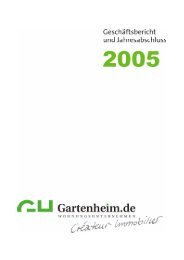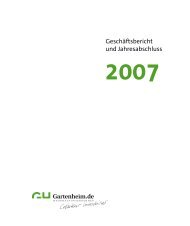analysis of the influences of solar radiation and façade glazing ...
analysis of the influences of solar radiation and façade glazing ...
analysis of the influences of solar radiation and façade glazing ...
You also want an ePaper? Increase the reach of your titles
YUMPU automatically turns print PDFs into web optimized ePapers that Google loves.
2.2 Experimental research methods 49<br />
k<br />
δ<br />
b<br />
eq = ,<br />
Rb<br />
where sf , h<br />
<strong>and</strong> ′′ sf , ∞<br />
(2.13)<br />
θ was measured on <strong>the</strong> hot side, θ sf , c on <strong>the</strong> cold side <strong>of</strong> <strong>the</strong> material’s surface<br />
q was obtained in steady-state.<br />
The next part <strong>of</strong> <strong>the</strong> study was dedicated to <strong>the</strong> unsteady tests. The temperature variations<br />
measured inside <strong>the</strong> sample were compared with <strong>the</strong> results <strong>of</strong> <strong>the</strong> numerical simulations in<br />
order to check if <strong>the</strong> heat capacity <strong>of</strong> <strong>the</strong> brick components was correctly estimated. A<br />
computational model was used (Fig. 2.6), which was implemented in <strong>the</strong> Fluent code by<br />
Miroslaw Zukowski according to EN 1745.<br />
Fig. 2.6: Sketch <strong>of</strong> <strong>the</strong> brick model developed by Miroslaw Zukowski.<br />
The experiment consisted <strong>of</strong> changing <strong>the</strong> specific heat capacity under numerical<br />
simulations <strong>and</strong> agreed with physical reality at an acceptable accuracy rate.<br />
The final results <strong>of</strong> experimental <strong>and</strong> numerical testing are presented in <strong>the</strong> third chapter <strong>of</strong><br />
this dissertation <strong>and</strong> <strong>the</strong> detailed information about all <strong>the</strong> experiment runs was submitted<br />
as a paper to <strong>the</strong> Energy&Buildings Journal.<br />
Apart from that, it should be noted that <strong>the</strong> <strong>the</strong>rmal resistance <strong>of</strong> <strong>the</strong> wall Req,w, which<br />
consisted <strong>of</strong> a Poroton-T9 <strong>and</strong> a mortar layer, can be treated as two resistances in a parallel<br />
circuit. Thus it is possible to apply <strong>the</strong> following equation:<br />
1<br />
R<br />
eq,<br />
w<br />
1 1<br />
= + .<br />
R R<br />
b<br />
m<br />
(2.14)





